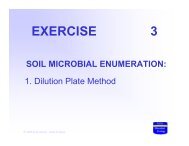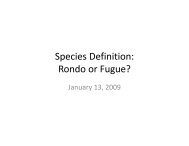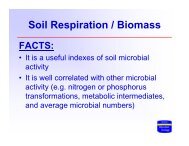Soil Microbial Ecology - Soil Molecular Ecology Laboratory
Soil Microbial Ecology - Soil Molecular Ecology Laboratory
Soil Microbial Ecology - Soil Molecular Ecology Laboratory
Create successful ePaper yourself
Turn your PDF publications into a flip-book with our unique Google optimized e-Paper software.
Page 61<br />
Mechanical lysis is introduced at this step. The protocol uses a combination of<br />
mechanical and chemical lysis. By randomly shaking the beads, they collide with one<br />
another and with microbial cells causing them to break open.<br />
7. Make sure the 2ml tubes rotate freely in your centrifuge without rubbing. Centrifuge<br />
tubes at 10,000-x g for 30 seconds. CAUTION be sure not to exceed 10,000 x g or tubes<br />
may break.<br />
What is happening: Particulates including cell debris, soil, beads, and humic acids,<br />
will form a pellet at this point. DNA is in the liquid supernatant at this stage.<br />
8. Transfer the supernatant to a clean microcentrifuge tube (provided).<br />
9. Note: With 0.25gm of soil and depending upon soil type, expect between 400 to<br />
450µl of supernatant. Supernatant may still contain some soil particles.<br />
10. Add 250µl of Solution S2 and vortex for 5 sec. Incubate 4°C for 5 min.<br />
What is happening: Solution S2 contains a protein precipitation reagent. It is<br />
important to remove contaminating proteins that may reduce DNA purity and inhibit<br />
downstream applications for the DNA.<br />
11. Centrifuge the tubes for 1 minute at 10,000 x g.<br />
12. Avoiding the pellet, transfer entire volume of supernatant to a clean microcentrifuge<br />
tube (provided).<br />
What is happening: The pellet at this point contains residues of humic acid, cell<br />
debris, and proteins. For the best DNA yields, and quality, avoid transferring any of<br />
the pellets.<br />
13. Add 1.3ml of Solution S3 to the supernatant (careful, volume touches rim of tube)<br />
and vortex for 5 seconds.<br />
What is happening: Solution S3 is a DNA binding salt solution. DNA binds to silica in<br />
the presence of high salt concentrations.<br />
14. Load approximately 700µl onto a spin filter and centrifuge at 10,000 x g for 1 minute.<br />
Discard the flow through, add the remaining supernatant to the spin filter, and<br />
centrifuge at 10,000 x g for 1 minute. Repeat until all supernatant has passed through<br />
the spin filter. Note: A total of three loads for each sample processed is required.<br />
What is happening: DNA is selectively bound to the silica membrane in the spin filter<br />
device. Almost all contaminants pass through the filter membrane, leaving only the<br />
desired DNA behind.<br />
15. Add 300µl of Solution S4 and centrifuge for 30 seconds at 10,000-x g.<br />
What is happening: Solution S4 is an ethanol based wash solution used to further<br />
clean the DNA that is bound to the silica filter membrane in the spin filter. This wash<br />
solution removes residues of salt, humic acid, and other contaminants while allowing





